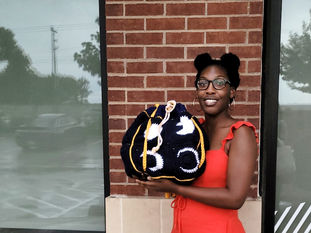
Frustrations, Math, and Triumph
We all have those projects that start with excitement and end in triumph—but somewhere in the middle, they drag us through a swamp of confusion. For me, that project was my graduation skirt. I wanted something unique, multi-colored, and perfectly fitted, with no room for error. The challenge? Making it work in the few months between September and December while juggling classes and volunteering.
What I didn’t fully realize at the time was that this skirt wasn’t just a crochet project—it was a geometry lesson disguised in yarn.
Math, Libraries, and the Power of Panels
I knew from the start that I wouldn’t have time to redo parts of the skirt. So, instead of making it one continuous piece, I chose to break it into six panels. Each panel could be detached and adjusted individually, making it easier to handle mistakes without reworking the entire thing. That decision, however, meant I had to work with 2D shapes on a 3D structure. Enter: Trapezoids, triangles, circles—and many, many trips to the library.
The panels were trapezoids, but the math didn’t stop there. I needed trigonometry (i.e. the Pythagorean theorem) to determine how long the skirt should be, pi and a tape measure to calculate the overall width, and I also had to factor in the thickness of the border. After countless hours of sketching, calculating, and double-checking with an engineering major (shout out to that friend), I finally worked out the precise dimensions. Each panel’s length and width translated easily into stitch and row counts. Now, don't get me wrong; it wasn’t easy—planning took several weeks, and the math was tedious. But once I got through the frustrating parts, I had everything I needed to crochet with confidence. The best part? I finished the skirt in time, complete with matching crocheted accessories like a purse, gloves, and a cap decoration.

All Crochet is Geometry
At the end of the day, this project reminded me of something fundamental: all crochet is geometry. Whether you’re working with flat, 2D shapes or sculpting 3D forms, the stitches are mathematical building blocks. Circles, rectangles, triangles, and curves are everywhere—you just have to spot them.
When you recognize the shapes within a pattern, you open up new creative possibilities. Understanding the basic geometry makes it easier to modify existing designs or create something completely new. The frustrating but rewarding journey of my skirt reminded me that math isn't just useful—it’s a tool that can bring your vision to life.
What’s Next for You?
If you’ve ever felt overwhelmed by the math in your project, you’re not alone—but don’t let that stop you. Start by breaking down your design into familiar shapes, sketching it out, and figuring out how the pieces fit. If you get stuck, reach out for help; engineers are especially handy—trust me. A little problem-solving goes a long way, and the results are worth the effort when your ideas finally take shape.

Challenge Yourself: Spot the Geometry in Your Projects
Next time you pick up your hook, challenge yourself to spot the shapes hiding in your stitches. Are you crocheting circles? Building up triangles? Creating textures that play with negative space? Embrace the G-word—geometry—and let it guide you to new and exciting designs.





